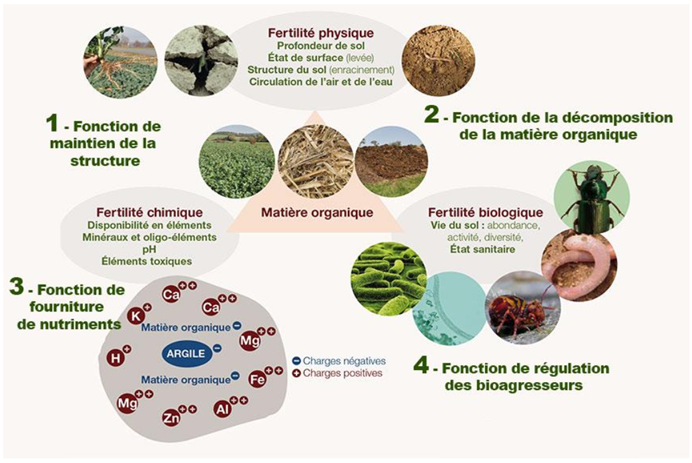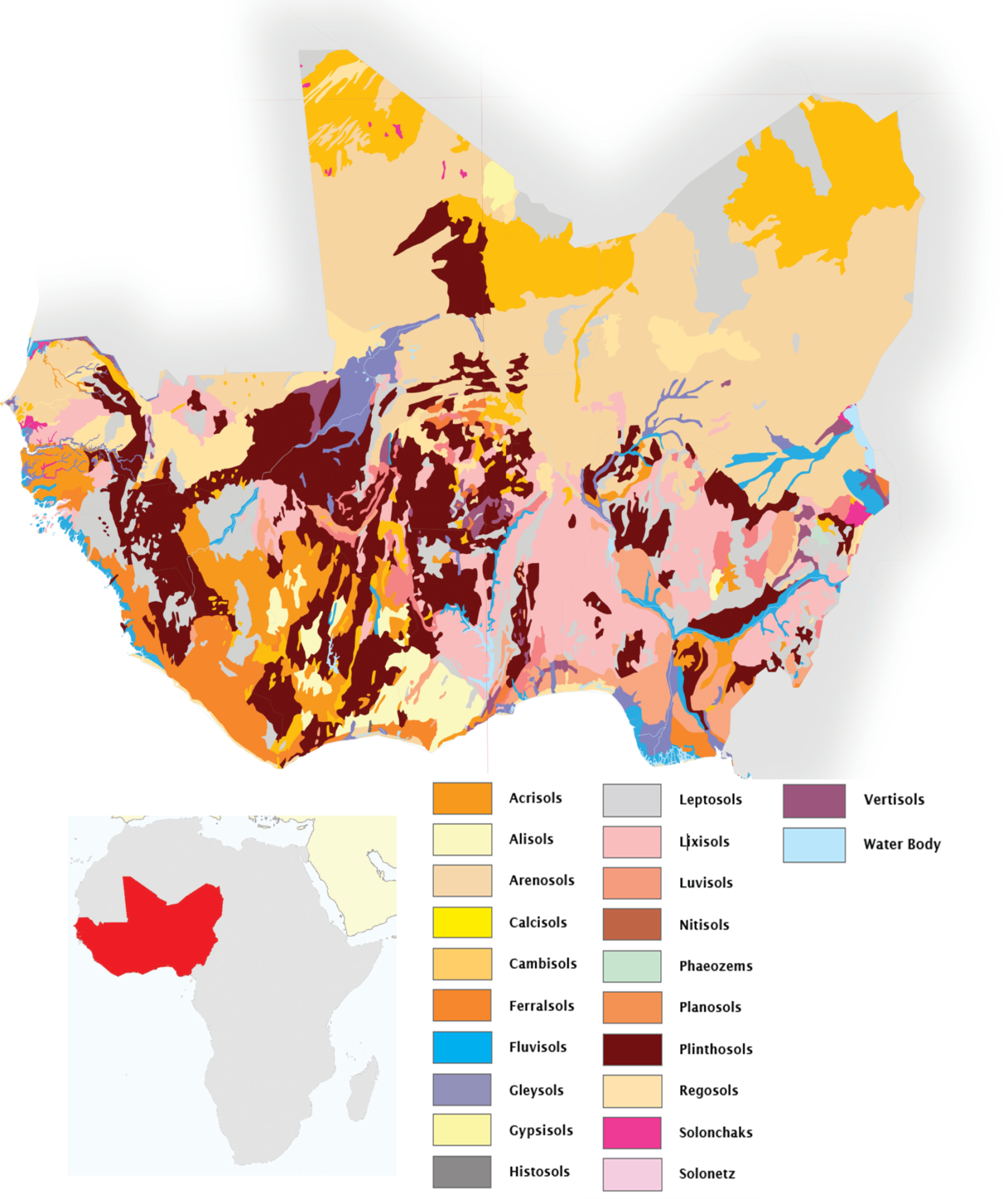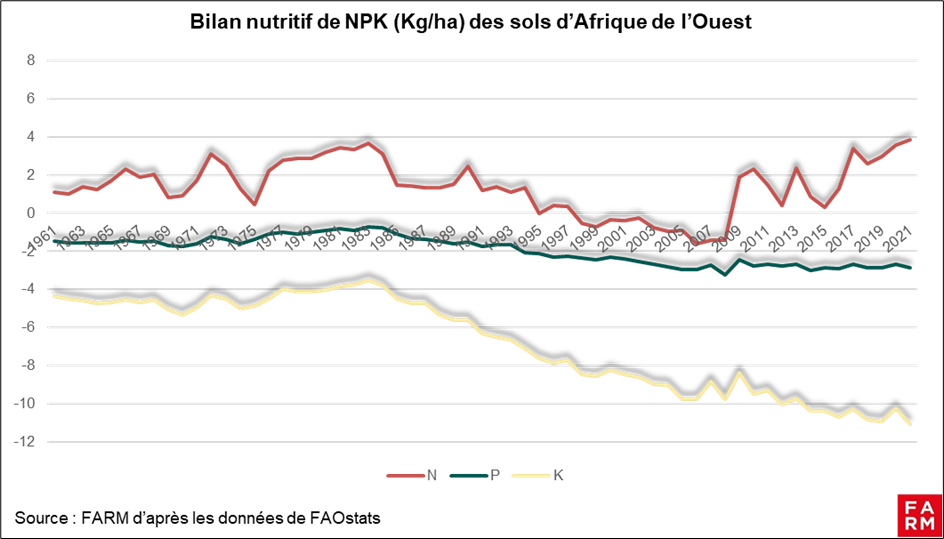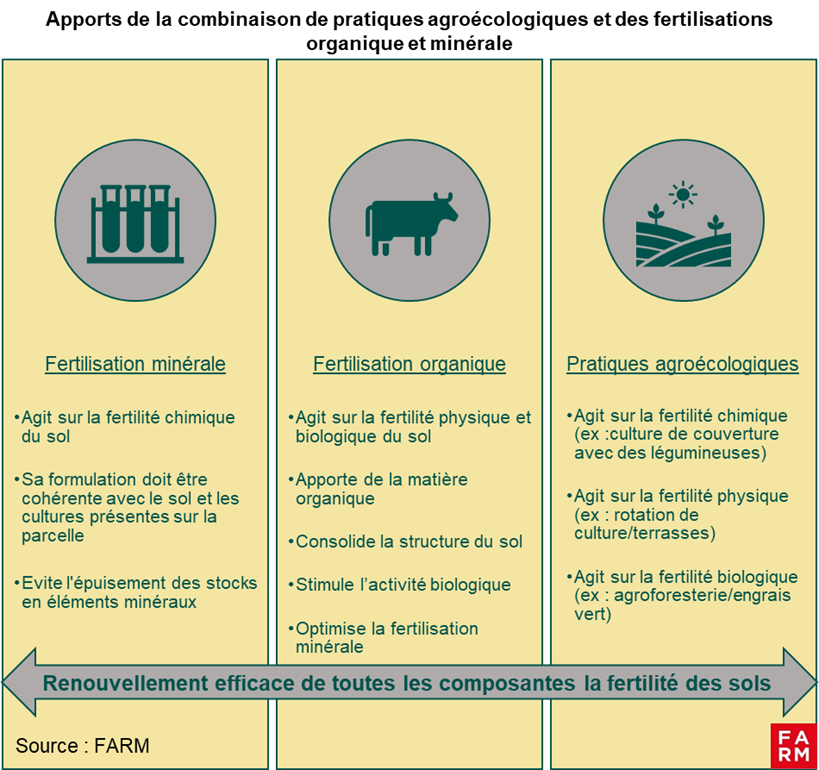Fertilizers and Soil Fertility in West Africa: Understanding Everything
Soil health and its ability to provide plants with what they need to thrive are key issues in West Africa. Several factors are putting significant pressure on these soils and limiting fertility renewal: climate change, economic and political crises, and a context of rapid population growth. Thibaut Soyez (FARM) takes stock of these issues and answers four key questions.
This text is the first in a series of three publications devoted to soil fertility and fertilizer use in West Africa. They were produced as part of a study conducted in partnership with the French Development Agency (AFD) to explain the controversies surrounding fertilizer use and shed light on current debates surrounding their use and complementarity with agroecological practices.
Question 1: What is soil fertility and how is it measured?
Soil fertility refers to the ability of a soil to provide the physical, chemical, and biological conditions necessary to support plant growth and productivity. It is a multidimensional concept and depends on agronomic contexts.[1]. It is essential to renew this capacity to maintain productionThe renewal of soil fertility is based on natural processes (decomposition of organic matter, recycling of nutrients) and agricultural practices such as the use of organic or mineral fertilizers, crop rotations or even agroforestry.
Assessing soil fertility can be done based on these four pillars:
Biological fertility which refers to the ability of soils to provide essential elements (mainly nitrogen, phosphorus and potassium) for plant growth through the action of living organisms (animals, insects, fungi, parasites). This action is characterized by the decomposition of plant and animal debris, thus releasing the nutrients necessary for plants.
Chemical fertility which corresponds to the pH of the soil, that is to say its acidity or alkalinity, and to the abundance of nutrients (nitrogen, phosphorus, potassium, etc.) in the soil as well as their availability for crop growth.

Soil fertility parameters (Source: Perrin, 2023)
Physical fertility of the soil which corresponds to its morphology (size, shape, arrangement, levels of organization) and its functioning (hydrodynamic, mechanical, agronomic, etc.).
The availability of organic matter, This is made up of living organisms (animals and plants), fresh, plant and microbial matter, as well as decomposing matter. Organic matter is a key pillar of soil fertility because it acts as a link between its different components. It influences the geochemical cycles of nutrients, water retention and structural stability.
These different components of soil fertility interact with each other. However, one last reference point must be added, that of economic fertility of the soil which takes into account the productive capacity of the soil as well as the associated costs and incomes and considers the profitability of investments to maintain or improve soil fertility. This is an essential dimension to analyze in the context of the objective of food sovereignty that more and more countries are setting themselves, particularly in West Africa.
Question 2: What is the nature of the soils in West Africa and what impact does it have on their fertility?
West Africa has mostly aged soils, that is to say deep soils whose pedogenesis (formation) is ancient and whose minerals have been strongly washed out (vertical movement of solid soil particles, particularly clays) or leached (movement of soluble elements in the soil, particularly mineral elements).
Although a great diversity of soils exists in West Africa (see map), the three main types of soils encountered are:
- THE lixisols (heavily leached and draining)
- THE acrisols (concentrated in clays and acids)
- THE plinth floors (high iron content, air hardens)

Figure 2: The different soil types in West Africa (Source: Jones, 2013)
Generally, these soils have a Acidic to weakly acidic pH, between 5 and 7. It should be noted that, below a pH of 6, the availability of most macro-elements is greatly reduced. In soils with a pH below 5.5, aluminum solubilizes and becomes bioavailable, which leads to toxicity for plant development. These tropical soils therefore retain few mineral elements, and their acidic to weakly acidic pH makes them poorly suited to absorption by plants.
West African soils also have low organic matter content, an essential component for soil fertility. This organic matter, a source of carbon, is essential for the development of biological life in the soil. In the region, between 40 and 60 tonnes of organic carbon per hectare are measured in the first metre of soil, a quantity considered low by INRAE [2].
The living organisms present participate, through the mineralization of organic matter, in making the mineral elements of the soil available for absorption by plants and in fine their development. The low proportion of organic matter in these tropical soils, accentuated by an acidic to weakly acidic pH, is a brake on the development of biological life in the soil.
The natural properties of the soils of the West African zone explain, at least in part, their low performance initial in terms of fertility. However, the state of a soil and its fertility also depend on its uses and the agro-system that occupies it.
Question 3: How can we explain the soil fertility crisis in West Africa?
Before getting to the West African soil fertility crisis, let's look at how this fertility was ensured.
Fertility transfers (processes that refer to the movement of fertilizing elements from one place to another) are at the heart of the fertility reproduction mechanisms of West African agricultural systems. To maintain the fertility level of a soil, nutrient intakes must compensate for withdrawals carried out via the harvests.

The soil fertility reproduction system was long balanced and based on traditional practices before a combination of endogenous and exogenous factors disrupted this balance.
Slash-and-burn agriculture is one of those ancestral agronomic practices that help maintain soil fertility. This system alternates periods of cultivation with long fallow periods, which can last up to 30 years. During this fallow period, vegetation and trees develop, draw mineral elements from the deep layers of the soil and return them to the surface via soil litter, thus restoring fertility.
In West Africa, the symbiosis between livestock and agriculture has long contributed to maintaining fertility. Fallow land served as pasture for cattle, whose droppings naturally enriched the soil and thus prepared the plot for the next sowing.
This practice was accompanied by other methods such as rotations and associations of crops, notably with legumes which naturally fix nitrogen from the air in the soil, as well as agroforestry, using, for example, the Faidherbia albida, which, through the deployment of its roots, structures the soil and, by capillarity, brings up the mineral elements present in the deeper layers of the soil, making them available to the plant. These traditional techniques formed a set of solutions adapted to effectively renew soil fertility. However, since the 1960s, various factors have disrupted this balance.
Rapid population growth In West Africa, with a population that doubled between 1950 and 1980, this put significant pressure on land resources. Faced with this situation, farmers had to adapt their practices, reducing fallow periods and expanding cultivated areas.

These changes have made obsolete the practice of slash-and-burn which no longer allowed for a natural and efficient renewal of the mineral elements in the soil. The expansion of cultivated land also modified traditional pastoral routes and accelerated deforestation, thus reducing the supply of organic manure.

This decline in fertility can be characterized by the nutrient balance in kg per hectare of cultivated land. N represents nitrogen, P phosphorus and K potassium. The graph indicates in West Africa a progressive decrease in the availability of essential mineral elements, particularly in potash and phosphate.
Agricultural intensification has thus generated a increased levy soil nutrients without sufficient restitution, creating a deficit in mineral elements, threatening agricultural productivity in a context of population growth. We must not forget that the demographic trend will continue since at the continental level the population will double by 2050.
Added to this situation are conflicts over land use between farmers and breeders, thus further limiting the input of organic matter permitted thanks to the agriculture-livestock association.
Climate change and droughts Recurring droughts have exacerbated these problems. Rainfall deficits, particularly marked since the 1960s, have contributed to land degradation, particularly in Sahelian zones, thereby limiting their productive potential.
These factors combined, on soils of already fragile nature, have led to a deterioration in soil quality at the chemical, physical and biological levels. The resulting decline in fertility has led to a decrease in agricultural productivity, jeopardizing food security in the region. Across the continent, FAO estimates that 1/5 of soils are in a state of severe degradation, with significant differences depending on the region and context.
West African agriculture therefore faces significant challenges. Finding and implementing sustainable solutions adapted to new climatic, demographic, and socioeconomic realities is vital for the region's food sovereignty.
Question 4: How can West African producers renew soil fertility?
Faced with the progressive decrease in the availability of essential mineral elements, in particular in potash and phosphate, a supply of mineral fertilizers adapted to soils and plants remains necessary to avoid the depletion of soil reserves. This supply, still too low today (15 kg/ha on average in West Africa compared to 120 kg/ha on average in the rest of the world) is however conditional on the capacity of producers to physically and economically access fertilizers which are often imported and subsidized [3].
To preserve the soil structure and optimize the effectiveness of mineral inputs, it is also necessary toincorporate organic matterThe contribution of organic matter is made possible in particular by the use of organic fertilizers, produced on the farm such as compost. [4] or manure for example, or by organic products from the industrial circuit. These elements will be detailed in a future publication which focuses on two case studies: the peanut basin in Senegal and the cotton-growing area of North Benin. This approach, combining mineral and organic fertilizers, is known as organo-mineral fertilization [5].
Beyond this method of fertilization, agricultural practices play a decisive role in renewing soil fertility. These approaches include, for example, the practices presented above, such as legume-based crop associations and rotations, agroforestry, burying crop residues, etc. However, the sustainable and effective implementation of these practices requires special attention to training and supporting producers, due to the specific characteristics and economic and agronomic possibilities of each farm.
It is also recommended to adopt techniques that preserve the structure of the soil by avoiding creating a dependence on mineral fertilizers and allowing production in situ of organic fertilizers.
The association of organo-mineral fertilization with agroecological practices adapted will also contribute to the restoration and maintenance of the fertility of West African soils. This integrated approach aims to reconcile the nutritional needs of crops with the long-term preservation of soil health, provided that the economic viability of farms is guaranteed.

In conclusion:
Scaling up practices and economic and physical accessibility of fertilizers
The increase in nutrient extraction from soils resulting from an intensification of production systems in many parts of West Africa, coupled with the reduction of fallow periods and the modification of pastoral rangelands, no longer allows for a sustainable renewal of fertility.
The main issue, however, is not in the identification of new practices that are already known (agroecology and organo-mineral fertilization), but in their scaling and their economic viability at the farm level. How, for example, can we reconcile a practice that consists of burying crop residues with a scarce workforce and without mechanical assistance? Or how can we implement an agroforestry system, requiring long-term investments, when land security is not assured? A forthcoming publication will examine this issue through two case studies: the groundnut basin in Senegal and the cotton-growing zone of northern Benin.
The challenge also lies in the availability both geographical and economic importance of mineral fertilizers and the availability of quality organic matterGeographically, mineral fertilizer distribution networks are still developing, limiting access in some regions. Furthermore, the breakdown of the traditional association between agriculture and livestock has reduced farmers' access to manure, forcing them to produce their own compost, often of inferior quality due to poor storage conditions. Economically, West Africa remains heavily dependent on imports of NPK mineral fertilizers, exposing the region to international market volatility, with fertilizer prices having tripled since the beginning of 2020.
Furthermore, the local organic fertilizer production sector is still emerging and requires investment to develop, as well as a coherent regulatory framework. Initiatives are underway to promote local and regional production of organic and mineral fertilizers, as well as to boost intraregional trade. However, given the needs, immense efforts are still required to meet the growing fertilizer demand and reduce dependence on imports. You will find an analysis of fertilizer production and supply in West Africa in future FARM publications.
[1] Reboul, C. (1989). Mr. Capital and Mrs. Earth: Agronomic Fertility and Economic Fertility. INRA. https://hal.science/hal-02858252/
[2] Storing carbon in French soils. What potential does it have in light of the 4 per 1000 target, and at what cost? July 2019.
[3] See the work of the FARM Observatory (https://fondation-farm.org/observatoire/accueil/) on this subject and the upcoming publications on fertilizer markets in West Africa
[4] Koulibi Fidèle Zongo: 2025 winner of the FARM Foundation Prize – FARM Foundation
[5] Falconnier, G. et al. (2023). The input reduction principle of agroecology is wrong when it comes to mineral fertilizer use in sub-Saharan Africa. Outlook on Agriculture, 0(0). https://doi.org/10.1177/00307270231199795
2 commentaires sur “Engrais et fertilité des sols en Afrique de l’Ouest : tout comprendre”
Leave a Reply
You must be logged in to post a comment.

NB. It is surprising that we do not question here the prices of fertilizers in the low use of chemical fertilizers in West Africa (and AFSS)... and therefore the prices of agricultural products of African farmers, confronted without sufficient tariffs at the borders, with global imports from high-productivity agriculture.
It is surprising that we are content with national statistics where the disparity in use between farmers (the most numerous, and the largest total areas) and agro-industrial areas is evident.
Only 2 allusions to prices as an essential factor of non-use in fertilizer articles:
cf. Article Phosphates which talks about fertilizer prices but still not economic accessibility by farmers in view of their selling prices:.. » The main obstacle to the use of phosphate fertilizers in West Africa remains their high cost. The prices of phosphates and more particularly of DAP (which represents more than 25 % of global trade) have increased significantly and experienced strong volatility. They have been largely impacted by the various crises of the last 15 years, thus aggravating the difficulty of access to phosphate fertilizers for countries and producers in the West African region. Thus, during the agricultural price crisis in 2008, DAP prices increased 4.3 times before falling and experiencing a new increase with the COVID 19 crisis and Russia's aggression against Ukraine, multiplying them again by 4 between 2019 and 2022. »
cf. Potash article. » This situation creates a vicious circle: low agricultural productivity increases food insecurity, while the high cost of inputs (especially in times of crisis) limits their accessibility for small farmers. The near impossibility of restoring significant quantities of potash to the soil without resorting to mineral fertilizers worsens the region's dependency situation and puts increasing pressure on West African food security.
You raise an important point, thank you for your comment. The price of mineral fertilizers is indeed a key factor influencing West African producers' access to these inputs. The low use of chemical fertilizers in the region is largely explained by their high cost, which is also subject to high volatility on the global market, particularly due to geopolitical crises.
This article, intended for educational purposes, focuses primarily on the technical and agronomic aspects of soil fertility and degradation in West Africa. However, we address economic issues in more detail in other publications, particularly on mineral fertilizer flows between West Africa and the rest of the world. Two upcoming articles, on soil fertility renewal in Benin and Senegal, will also address the cost of mineral fertilizers.
To give you an idea, between 2020 and 2022, the price of nitrogen increased 4.5-fold, that of potash 2.7-fold, and that of phosphates 3.2-fold. This volatility impacts access to fertilizers for the most vulnerable producers. Furthermore, the disparity in use between small producers and agro-industrial areas is an aspect that we also examine in our work.
A Policy Brief addressing issues of public support for fertilizers will soon be published in the AFD's "Public Policy Dialogue" collection. Follow the Foundation's news to find out more!